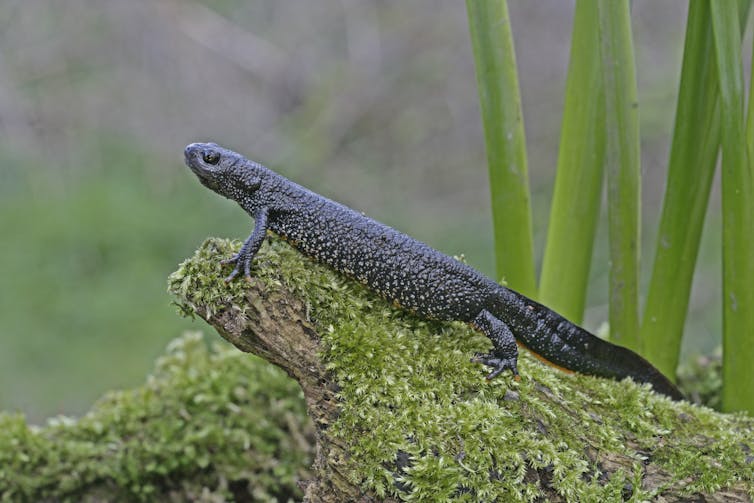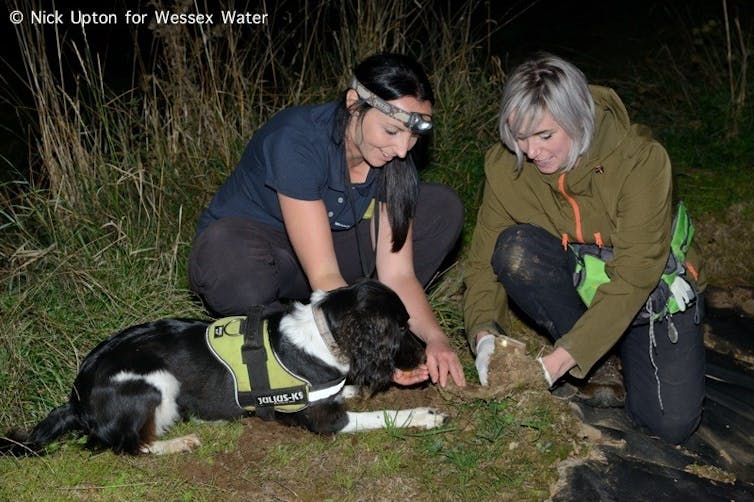Construction projects often find themselves at odds with the great crested newt. In 2020, the then UK prime minister, Boris Johnson, referred to them as a drag on the economy, citing their presence on development sites as a cause for costly delays. These creatures even put a stop to Ed Sheeran’s proposal to build a wedding chapel on his Suffolk estate.
Great crested newts play crucial ecological roles. They breed in ponds and ditches during the spring and early summer, before emerging to spend most of their time on land. This behaviour means they are able to recycle nutrients from water to land.
They are also an important part of the food chain. These newts eat small invertebrates and are prey for many species of reptile, mammal and bird.
But great crested newt populations are dwindling due to the widespread loss of suitable habitat, changes in farming practices and climate change. There are now only 478,000 ponds remaining in the UK’s countryside – a 50% decline compared to a century ago – and only 20% of the remaining ponds are suitable for breeding great crested newts.
So it’s no surprise that harming these creatures or their habitats is now illegal. Developments that may harm great crested newts can proceed only if suitable new habitats are made for them.
But the current methods for relocating newts, which include the installation of drift fencing, pitfall traps (sunken buckets in the ground) and searching by hand, are time-consuming, restricted to certain seasons, expensive and are often hampered by the weather. Great crested newts also tend to hide underground in mammal burrows and other inaccessible refuges, where they are hard to locate.
However, my colleagues and I have discovered that detection dogs can be a valuable addition to the existing toolkit for managing great crested newt populations.
A trained English springer spaniel, called Freya, was highly accurate at detecting great crested newts, even at distances of up to 2 metres above the ground (87% accuracy) and through 20cm of soil (88% accuracy). This approach offers a non-invasive method for locating this species in inaccessible underground shelters.

Dog detectives
Over 128 trial runs, we conducted experiments to investigate the impact of various distances between target newts and Freya on her ability to locate them. We also tested how well Freya could detect the newts through two different soil types: clay and sand. In some instances, we placed a vent within the soil to mimic a mammal burrow.
Freya accurately located all individual great crested newts across the entire range of tested distances (0.25 metres–2 metres). When Freya detected the smell of a great crested newt, she would lie down and point at where the scent was emerging from.
Freya could locate individual newts both in soils with and without vents. But she was significantly faster and more accurate at detecting newts under clay soil compared to sand. This finding contrasts with previous research that found dogs were able to detect human remains under sandy soil much faster and more accurately than in clay soil.
Our results are likely to do with the type of odour that is emitted and how it reacts with the soil. Great crested newts are amphibians and use moisture to transport pheromones (a chemical that is secreted into the environment to attract a mate for breeding) during their aquatic life phase. The presence of moisture within clay soil may transport their odour to the surface more readily than in sandy soil.
We also found that air temperature influenced how quickly and accurately Freya could detect the newts. Moisture will evaporate at the surface when it’s hot, making it harder for dogs to locate the scent.
Not so fast
Using detection dogs to locate great crested newts underground offers valuable insights into the habitat that newts prefer. It also serves practical purposes. Finding and relocating newts is costly and time-consuming at present, but a legal requirement prior to construction activities.
Our findings provide a better understanding of the factors, such as temperature and soil type, that can hinder or improve the chance of detecting these newts. But they also highlight the need for detection dog handlers to be aware of their environmental surroundings and how these factors may impact the dispersal of the newts’ odour.
Furthermore, training dogs and handlers to find great crested newts takes a long time. In fact, it can take up to two years for a dog and its handler to become operational.
This is due to the complexity of the newts’ lifecycle. Great crested newts spend time both above and below the ground, as well as in inaccessible underground hiding places. As a result, the dogs must be exposed to all different types of scenarios during training to ensure they can accurately distinguish between a scent that is accessible above the ground, and a more diluted scent at a distance.

Using detection dogs to locate hidden great crested newts has the potential to protect this rare species and reduce costly construction delays. But the complexity of the newts’ life phases and the time-consuming training process for dogs and handlers means it will take time before this effective new method becomes commonplace.
Nikki Glover does not work for, consult, own shares in or receive funding from any company or organisation that would benefit from this article, and has disclosed no relevant affiliations beyond their academic appointment.
This article was originally published on The Conversation. Read the original article.







